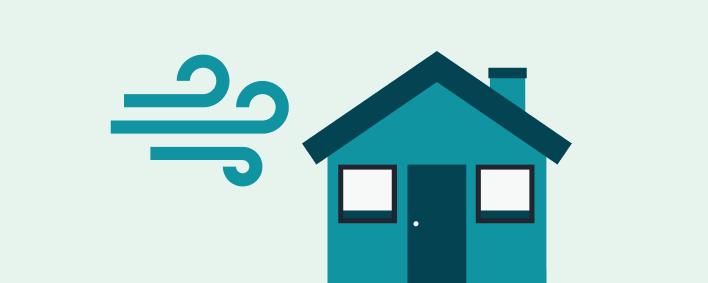Windstorm Insurance: What Is It and How Does It Work?
Our goal is to give you the tools and confidence you need to improve your finances. Although we receive compensation from our partner lenders, whom we will always identify, all opinions are our own. By refinancing your mortgage, total finance charges may be higher over the life of the loan.
Credible Operations, Inc. NMLS # 1681276, is referred to here as “Credible.”
Owning a home often comes with unexpected expenses like maintenance, landscaping, and repairs. You’ll also need to pay for homeowners insurance to protect your home against damages.
But did you know that you might need to purchase windstorm insurance, too? Most homeowners insurance policies include some protection against windstorms, but you may need more protection. In that case, you’ll need to make an additional purchase of windstorm insurance.
Here’s what you need to know about windstorm insurance:
What is windstorm insurance?
Windstorm insurance protects your home from damaging winds produced by hurricanes, hail, or tornadoes. Windstorm insurance may also be called hurricane insurance.
If a windstorm damages your property, a windstorm policy will cover the cost of damage, minus your windstorm deductible. In some high-risk coastal areas, windstorm insurance isn’t included in your homeowners insurance policy. Most mortgage lenders will require you to add the benefit as a rider on your policy in this situation.
What windstorm insurance covers
Windstorm insurance coverage helps pay to repair or replace your home and belongings if a qualifying weather event causes damage or destruction. But windstorm policies won’t cover all your costs. Like many other types of insurance, they have deductibles — an amount you’ll pay out of pocket before your insurance coverage begins to pay for damages.
Unlike other types of insurance that have flat amount deductibles, windstorm deductibles are typically a percentage of the home’s value. They can range from 1% to 10% of a home’s value, according to the National Association of Insurance Commissioners.
- Hurricane or named storm deductibles apply to any damage from named hurricanes or tropical storms. A named hurricane is one that has been given a formal name by the National Hurricane Center, National Weather Service, World Meteorological Association, or other similar organizations. If you’re a resident of a coastal state, you’ll likely need (and want) to add this rider to your policy. These deductibles are usually a percentage of your dwelling coverage (Coverage A) or personal property coverage (Coverage C).
- A windstorm or wind/hail deductible applies to any other wind damage or damage that hail causes. Like hurricane or named storm deductibles, windstorm deductibles are a percentage of your dwelling coverage.
Perils that a windstorm insurance policy covers include:
- Hurricanes
- Hail
- Straight-line winds
- Tornadoes
Check out: Homeowners Insurance Deductible: What You Need to Know
What windstorm insurance doesn’t cover
Windstorm insurance is a very niche area of coverage. You might be surprised to find that your windstorm insurance policy doesn’t cover certain damage to your home after a major storm.
Perils not covered by windstorm insurance include:
- Flooding
- Earthquakes
- Mold damage that’s not caused by a named peril
How much windstorm coverage do you need?
The amount of coverage you need will vary depending on your specific circumstances. Your overall homeowners insurance policy should ideally have enough coverage to pay for the entire cost of rebuilding your home.
Your windstorm insurance deductible will generally be a certain percentage of your dwelling coverage (the structure of your home) or your personal property coverage (the contents of your home). Most insurance providers offer deductibles between 1% and 10% of the total value of your home. For example, windstorm insurance on a $350,000 house might give you a deductible between $3,500 and $35,000.
When deciding how much coverage you need, consider your budget: Would you be able to afford, say, $35,000 out of pocket to repair damage to your home? With a higher deductible, you’ll save money on your premium, but you’ll pay more out of pocket if you file a claim. A lower deductible will make your premium more expensive but will help you save money if you ever need to file a claim.
You’ll also want to think about your risk level. If you live in an area that’s more prone to windstorms, you may want more coverage.
Learn More: How Much Homeowners Insurance Do I Need?
What factors affect the cost of windstorm insurance?
The cost of insurance varies depending on income, according to a survey by the National Association of Insurance Commissioners. Higher incomes typically mean more expensive homes and more expensive insurance policies.
Other factors affect the cost of your windstorm insurance, too.The factors that impact the cost of windstorm insurance are generally the same as those that impact the cost of your overall homeowners insurance policy. The most common contributing factors to the cost of windstorm insurance include:
- Location of your home
- Age of your home
- Type of materials used to build your home
- Risk level (Homes located in higher-risk areas are more expensive to insure.)
- Deductible
Homes in coastal areas and states with more frequent severe storms are likely to have higher windstorm insurance rates. Currently, 19 states have a hurricane or named storm deductible:
The District of Columbia also has a named storm deductible in place. These states are also more likely to be hit by hurricanes or tropical storms.
Learn More: What Does Homeowners Insurance Cover?
How to file a windstorm insurance claim
If you’re going to pay for windstorm insurance, you’ll need to know how to file a claim. Hurricane and windstorm riders have deadlines for claims, and you could miss out on funds to help repair damage to your home if you don’t act quickly.
For example, in Connecticut, you can use your hurricane deductible until 24 hours after the National Hurricane Center’s termination of the last hurricane warning for any part of the state, or 24 hours after the National Hurricane Center’s last downgrade of the hurricane from hurricane status for any part of the state, whichever happens earlier.
You should also know whether your policy covers a single event, an entire season, or a full year. It’s important to read your policy carefully to ensure you have the proper coverage.
You’ll generally need to follow these steps to file a windstorm insurance claim:
- Once your family is safe, and the storm has passed, assess the damage to your home. Contact your insurance agent and let them know that you’ve had damage to your property and that you’ll be filing a claim.
- Next, do what you can to prevent further damage. For example, you may want to cover broken windows or holes in the roof with a tarp to protect your property. If you have to buy anything to take care of these tasks, hold on to your receipts — your insurance carrier may reimburse these expenses.
- Don’t make any significant or permanent repairs until your insurance provider inspects the damage and you agree on the cost of the repairs. Your insurance carrier will send out an adjuster to inspect your property. It’s also important not to discard anything until you’ve checked with your insurance provider.
- Take as many photos of the damage to your property as possible. Your insurance carrier will want to make sure the damage qualifies. Also, make a detailed list of your losses, including the item, brand name, and price, if possible. Detailed notes and images will make getting the funds to replace what you lost more straightforward. If your home is uninhabitable, talk to your insurance carrier to find out what it’ll reimburse.
- A claims adjuster will visit the property to take notes and measurements. Ask your claim adjuster if you can provide additional information to move things along faster. Once your adjuster sends you an estimate of the damage, you can look for contractors to make repairs. You’ll want to provide contractor paperwork and bids for your insurance carrier’s records.
Learn more: Everything You Need to Know About Home Insurance Claims
How to get windstorm insurance
If you already have a homeowners insurance policy, you can add a windstorm coverage rider to your existing policy. Your monthly payment may increase slightly, but you can rest easy knowing you have additional protection.
Alternatively, you can purchase windstorm insurance through specialty insurers or your state’s Fair Access to Insurance Requirements (FAIR) Plan. The program offers insurance to homeowners who may not otherwise be able to obtain homeowners insurance due to high risk exposure.
In addition, seven Atlantic and Gulf states provide specific Beach and Windstorm Plans. FAIR Plans are often a little more expensive than private insurance and can be challenging to get. They may also offer less coverage than other plans, but they may be the only plans available in your area.
Your home is a significant financial investment. Spending a little extra money to protect that investment is a wise financial move.
Disclaimer: All insurance-related services are offered through Young Alfred.




